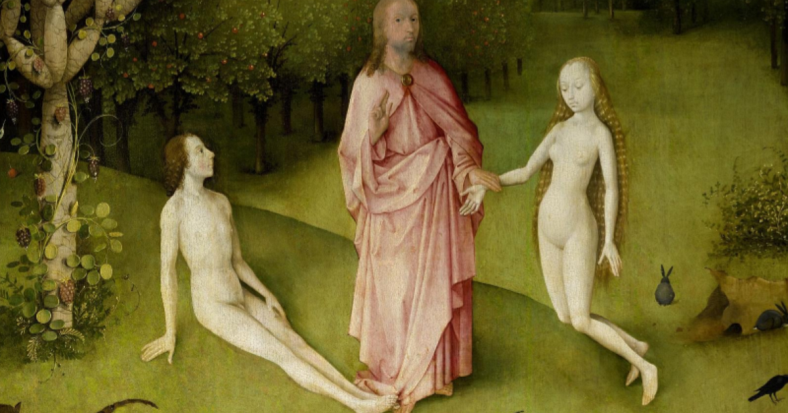This Week’s Prompt:51. Enchanted garden where moon casts shadow of object or ghost invisible to the human eye.
The Resulting Story: There is a Garden atop a Mountain
Now we begin a venture into two separate realms, both of shadow and of gardens, and what is in between. The central place in this story is something of an uncanny places, where the unseen is temporarily perceptible under the moon (who’s various shapes we recorded here). A moonlit walk in a garden is an almost romantic view of something unseen.

Look at this dork. Hey Carl.
The role of a garden is important however. Garden’s have long had a place in Western thought, as places of cultivated nature that appear wild. Carl Linnaeus, an advocate for the idea of a fixity of species, viewed the world as a well cultivated garden, with the Lord as it’s gardener. This connects to the presentation in Western mythos of the Garden of Eden, where the lord tends to all things. It is a symbol of cultivation, growth, and to a degree riches. YHVH is not the only god with gardens however. The Greeks had the Hesperedies and some sources point to Indra possessing a celestial garden. Peach trees were cultivated by the celestial bureaucracy of China, and fruits of immortality were also grown by the Norse gods.

This is cropped from the Garden of Earthly Delights. It gets weirder. See the cover pic? Yeah…
The connection with gods and gardens is more than something exclusive. Temples and monasteries often maintained gardens, either for contemplation or meditative purposes. These are separate from the wild places of the world, sacred groves and mountains that are maintained as wild as opposed to cultivated, and separate from those agricultural lands devoted to a temple that would often be redistributed among the public.
The most famous of these gardens are the Zen gardens of Zen Buddhism and Mary gardens of christian practice. I would point, briefly, to a wonderful story concerning monastic grounds and the discovery of a statue there in. It’s either a horror or humor story,depending on your own take. For me it was both.

The connection between gods and gardens is more than just a potential connection of cultivation of the earth and tameness. It is also one of riches and authority. Gardens in ancient Egypt were known for providing nobility shade. Assyrian gardens were vaster complexes, given over to hunting areas of leisure. Gardens often in later times provided vegetables for manor houses. The garden was, in many ways, a symbol of riches and cultivation.

The most famous of this category, without a doubt, is the Hanging Gardens of Babylon…which there is no archaeological evidence for in Babylon, although Nineveh may be their true home. All the better, if we are to work in mythology then. The gardens, one of the Seven Ancient wonders of the World, were built according to multiple informants to replicate the green hills of a queen’s homeland that she dearly missed. They are often raised or tiered, hence “hanging”, and have marvelous aqueduct systems to supply water to the trees.
Gradens thus already have something of the uncanny in them. They are close to gods, and by extension kings, and could be arranged as something liminal between the wilderness and the civilized lands. Particularly in periods where a garden served as much as a hunting reserve as it is a place for the gathering of fruits. The shadow is just as much, if not more, of a liminal thing.
Shadows have been tied to the realm of the dead for a considerable amount of time. The word “shade” shares an origin with shadow, obviously, and many descriptions of the afterlife in the near east place it in shadow. The shadow or shade is where the dark and light intermingle in a way. There are also reports, in the last few decades, of mysterious shadow people who may be reiterations of this older mythology.

The loss of a shadow is bemoaned in many stories, although I cannot find any particularly old folklore. We have works by Dunsany that involve selling one’s shadow, a darker tale by Hans Christen Anderson where one’s shadow leaves and becomes a rather wicked man, a story of being shunned by society for lack of a shadow. In older mythology, the shadow sometimes reveals a creatures true intentions, as a reflection might. For instance, the Kitsune’s shadow is that of a fox demon regardless of her form. The devil has some associations with the shadows as his role of prince of darkness, helped by the Jungian concept of the shadow (We will get to that shortly).

I feel like linking to “She’s a Maneater” here would be tasteless
Not all creatures of shadow are wicked, however, as the Sun god Surya in Hindu myth has married the goddess of shadow, and biblical passages often refer to the Lord as providing shade from the harshness of the sun. Dark isn’t evil I suppose.
Which brings us to the psychological shadow. The shadow, as conceived by the pyschoanalysist Carl Gustav Jung, is the result of repressed emotions and thoughts from the self. It has something in common with the Id of Freudian analysis, but is less inherently antagonistic and sexual. The shadow is better thought of as the opposite in the mind, rather than the barely contained chaotic.

Ha. Look at this other dork. Also named Carl. Hi Carl.
The shadow as the source of a true self, as hidden hold of the soul, actually works fairly well with the notion of the Garden to a point. The graden is a place of divinity and sacredness, and while the shadow may be something profane, it is also a signifer of something human and sacred. The shadow, like the garden, is something of revelation of character. It is the place where perhaps truth about the self comes out.
Alternatively, it might be better to have the garden by a place of confrontation with some spiritual force. This could call on a Lovecraft theme of seeking forbidden knowledge (And oh, wouldn’t that have a western parralel in Christianity!), and the shadow is often an uncomfortable thing to confront.
Said gardens, especially those that have been trespassed before, have guardians. The Hesperedies have the great dragon, and the Garden of Eden has the four headed cherubim, an angel of truly terrible appearance and power with a flaming sword that strikes in every direction. The Lovecraftian equivalent is an embodiment of time, of Yog-Sothoth, who guards the sleeping ancient ones. In the story of Death’s Master, Tales of a Flat Earth points to another sacred garden guarded by many fierce beasts. So too will our garden be guarded by dreadful things.

Pop Quiz: Are these four-headed winged warriors from Lovecraft or Ezekiel?
But then we have a new problem. What is in the garden that is so valuable. We could do well with fruits, I think. Fruits of immortality are common, but something interesting might come of using the apples of an odder sort: the golden apples of Perun. These are not tools of eternal life but items of ultimate destruction. Of course, perhaps there is a connection between the two concepts. Lighting and diamonds are often connected as symbols of enlightenment, power and durability. But that is secondary to the goal.
So our story will be of an expedition. I think at least two maybe three individuals, climbing the mountains in some far off land, to find the garden. The second portion will be the confrontation with the guardian, perhaps at the cost of life for one or two members. And then in the garden, they will find the shadows of those unseen. Perhaps hidden masters who have already partaken of the fruit, perhaps new guardians and gods enraged at being disturbed by mortal hands.
Or, perhaps, hunters in their garden surprised at new prey. We shall see.
If you’d like to support the Society, receive more stories or research, or are feeling generous, please check out our Patreon here.

